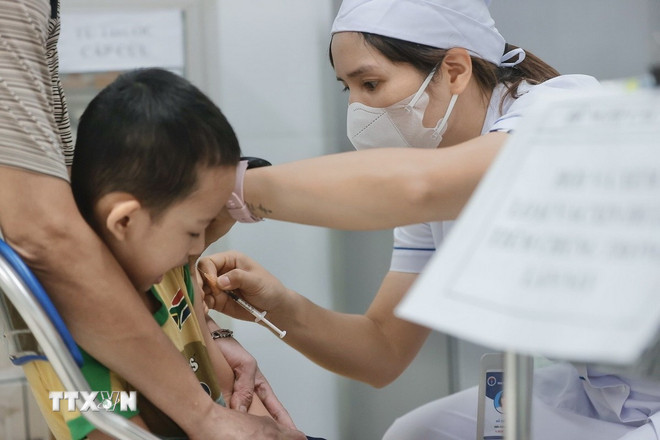On July 16, the World Health Organization (WHO) and the United Nations Children's Fund (UNICEF) in Vietnam informed that the estimated national immunization coverage (WUENIC) data in Vietnam collected and published by the two organizations showed that Vietnam has made significant progress in protecting children from vaccine-preventable diseases.
By 2024, Vietnam will achieve a 99% vaccination rate for the first dose of diphtheria, tetanus, and pertussis vaccine, up from 80% in 2023. Vaccination coverage in Vietnam will not only recover to pre-COVID-19 high levels but will also be higher than the vaccination rate in 2019.
Accordingly, the number of children who have not received any vaccine doses, also known as the “0-dose vaccine” group, has decreased from 274,000 in 2023 to 13,000 in 2024, equivalent to a reduction of more than 95%.
This significant reduction shows that more Vietnamese children are being protected from vaccine-preventable diseases.
By 2024, Vietnam will have a vaccine coverage rate higher than the global average thanks to strong leadership from the Government , timely vaccine supply, and tremendous efforts from health workers, parents and communities.
According to Dr. Jennifer Horton, WHO Deputy Representative in Vietnam, these estimates are evidence of the efforts of the Vietnamese health sector to boost vaccination coverage after the pandemic and during the measles outbreak in 2024-2025. Nearly 1.3 million children were vaccinated during the 2024-2025 measles vaccination campaign.
“These encouraging figures from Vietnam are a tribute to the thousands of health workers who have worked day and night to restore immunization services after a prolonged disruption due to the pandemic and vaccine shortages,” Dr. Jennifer Horton emphasized.
Dr. Nguyen Huy Du, Acting Head of the Child Survival and Development Program, UNICEF Vietnam, said: “This achievement strongly reflects Vietnam's steadfast commitment to child health and the strength of its primary health care system.”
“With 1.8 million children in the East Asia -Pacific region still unvaccinated, Vietnam’s success sends a clear message: with strong political will, timely and adequate supply of vaccination materials, out-of-office vaccination and community engagement, immunization for every child is possible. We commend the Government of Vietnam for its leadership in closing the vaccine access gap and ensuring no one is left behind,” said Dr. Nguyen Huy Du.
Vietnam also recorded a 32% increase in the proportion of children vaccinated with three doses of diphtheria, tetanus and pertussis vaccine, reaching 97% in 2024, up from 65% the previous year. This not only shows improved access to vaccines but also demonstrates close adherence to completing the full vaccination schedule.

In addition, coverage of the first dose of measles vaccine also increased significantly, from 82% in 2023 to 98% in 2024, helping to protect more children from one of the most contagious infectious diseases.
However, according to WHO and UNICEF, Vietnam still faces many challenges. There are still 40,000 children who have not received the third dose of the diphtheria, tetanus, and whooping cough vaccine and 27,000 children who have not received the first dose of the measles vaccine.
These numbers demonstrate the need for continued investment in community outreach, health worker training, and communications to combat vaccine misinformation.
Unvaccinated and under-vaccinated children occur for many reasons, including geographical barriers, limited access to services in remote or underserved areas, and the lingering effects of COVID-19 on health systems.
Ensuring safe and uninterrupted vaccine supply chains, especially during the current health system restructuring, will be crucial to maintaining high vaccination coverage.
To address the challenges, WHO and UNICEF say the Government should encourage private health care services to be involved in delivering routine immunization.
Local authorities need support to implement appropriate vaccination strategies to reach the most vulnerable populations.
WHO and UNICEF also recommended that the Vietnamese Government continue its efforts to accelerate catch-up vaccinations for children, especially in hard-to-reach communities; emphasizing that even small gaps in vaccine coverage can lead to dangerous disease outbreaks and put additional pressure on the health system.
WHO and UNICEF affirmed that Vietnam's efforts show that even when facing global challenges, countries that take drastic actions can still achieve many encouraging results through targeted strategies and focus on equity in vaccine access./.
Source: https://www.vietnamplus.vn/viet-nam-giam-hon-95-so-tre-0-lieu-vaccine-chi-trong-mot-nam-post1050001.vnp



![[Photo] General Secretary To Lam receives US Ambassador to Vietnam Marc Knapper](https://vphoto.vietnam.vn/thumb/1200x675/vietnam/resource/IMAGE/2025/9/29/c8fd0761aa184da7814aee57d87c49b3)
![[Photo] General Secretary To Lam chairs the meeting of the Central Steering Committee on preventing and combating corruption, waste and negativity](https://vphoto.vietnam.vn/thumb/1200x675/vietnam/resource/IMAGE/2025/9/29/fb2a8712315d4213a16322588c57b975)
![[Photo] National Assembly Chairman Tran Thanh Man chairs the 8th Conference of full-time National Assembly deputies](https://vphoto.vietnam.vn/thumb/1200x675/vietnam/resource/IMAGE/2025/9/29/2c21459bc38d44ffaacd679ab9a0477c)
![[Photo] Many streets in Hanoi were flooded due to the effects of storm Bualoi](https://vphoto.vietnam.vn/thumb/1200x675/vietnam/resource/IMAGE/2025/9/29/18b658aa0fa2495c927ade4bbe0096df)
![[Photo] General Secretary To Lam attends the ceremony to celebrate the 80th anniversary of the post and telecommunications sector and the 66th anniversary of the science and technology sector.](https://vphoto.vietnam.vn/thumb/1200x675/vietnam/resource/IMAGE/2025/9/29/8e86b39b8fe44121a2b14a031f4cef46)




































































































Comment (0)